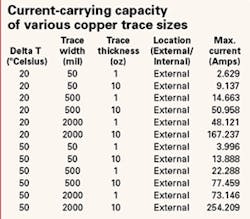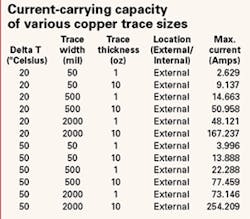Heavy copper circuit boards offer improved power handling and reliability in extreme condiditions
By John Vandersleen and David Basista
Many new power-electronics products are designed specifically for military and aerospace applications, and more and more of these projects are taking advantage of a new trend in the printed-wiring-board industry: heavy copper circuits.
What defines a heavy copper circuit? Most commercially available printed wiring boards use copper traces and planes with weights of one-half to three ounces per square foot. Designers manufacture heavy copper circuits, on the other hand, with copper weights of anywhere between four and 60 ounces per square foot. The increased copper weight combined with a suitable substrate transforms the once-unreliable and weak circuit board into a durable and reliable wiring platform.
Current capacity and temperature rise
Designers who wish to use heavy copper circuits in their projects often ask what is the amount of current that a copper circuit can carry. The amount of heat rise their projects can withstand is important because heat rise and current flow go hand in hand.
When current flows along a trace a power loss results in localized heating. The trace cools by conduction into neighboring materials and by convection into the environment. To find the maximum current a trace can safely carry, designers need to find a way to estimate the heat rise associated with the applied current.
An ideal situation would be to reach a stable operating temperature at which the rate of heating equals the rate of cooling. There has been some work done on this subject and Douglas Brooks of UltraCAD Design Inc. in Bellevue, Wash., has developed a model based on extensive testing of external traces.
These internal traces should be derated by an estimated 50 percent for the same degree of heating. The table shows the current-carrying capacity of several traces of different cross-sectional areas. What is an acceptable amount of heat rise will differ from project to project; most circuit-board dielectric materials can withstand temperatures of 100 degrees Celsius above ambient; although this amount of temperature change would be unacceptable in most situations. The results of this analysis lead to a fairly reasonable, intuitive understanding of the dynamics involved.
Board strength and survivability
Circuit-board manufacturers and designers can choose from a variety of dielectric materials, from standard FR4 — with an operating temperature of 130°C — to high-temperature polyimide — with an operating temperature of 250°C. A high-temperature or extreme-environment situation may call for an exotic material, but if the circuit traces and plated vias are standard 1-ounce copper, will they survive the extreme conditions?
The circuit-board industry has developed a test method for determining the thermal integrity of a finished circuit product. Thermal strains come from various board fabrication, assembly, and repair processes in which the differences between the coefficient of thermal expansion and the laminate provide the driving force for crack nucleation and growth to failure of the current-carrying capability of the board.
Thermal cycle testing (TCT) checks for an increase in resistance of a circuit as it undergoes air-to-air thermal cycling from 25°C to 260°C. An increase in resistance indicates a breakdown in electrical integrity via cracks in the copper circuit.
A standard coupon design for this test incorporates a chain of 32 plated through holes, which has long been considered to be the weakest point in a circuit when subjected to thermal stress.
TCT studies done on standard FR4 boards with 0.8- to 1.2-mil copper plating have shown that 32 percent of circuits fail after eight cycles; a 20 percent increase in resistance is considered a failure.
TCT studies done on exotic materials show significant improvements to this failure rate; Cyanate Ester, for example, shows a 3 percent failure rate after eight cycles. Exotic materials, however, are prohibitively expensive — five to 10 times the material cost of standard materials — and are difficult to process.
An average surface-mount technology assembly sees a minimum of four thermal cycles before shipment, and could see an additional two thermal cycles for each component repair, for a total of six.
It is not unreasonable for a solder mask over bare copper board that has gone through a repair and replacement cycle to reach a total of nine or more thermal cycles. The TCT results clearly show that the failure rate, regardless of the board material, can become unacceptable.
Copper electroplating is not an exact science; changes in current densities across a board and through numerous hole/via sizes result in copper thickness variations of as much as 25 percent. Most areas of "thin copper" are on plated hole walls; the TCT results clearly show this to be the case. Using heavy copper circuits would reduce or eliminate these failures altogether.
An additional ounce of plated copper to a hole wall reduces the failure rate to almost zero. In fact, TCT results show a 0.57 percent failure rate after eight cycles for standard FR4 with a minimum of 2.5-mil copper plating. In effect, the copper circuit becomes impervious to the mechanical stresses placed on it by the thermal cycling.
Benefits of heavy copper
Among the many benefits of using heavy copper circuitry are:
- increased resistance to thermal strains;
- increased current-carrying capacity;
- the ability to use exotic materials to their full potential (i.e. high temperature) without circuit failure;
- the ability to shrink product size by incorporating several copper weights on the same layer of circuitry;
- increased mechanical strength at connector sites and in PTH holes;
- the ability to use heavy copper plated vias to transfer heat to an external heat sink;
- the ability to build heat sinks directly onto the board surface using cooper planes as heavy as 60 ounces; and
- the ability to produce high-current planar transformers.
The manufacture of heavy copper circuits usually involves significant plating thicknesses and therefore allowances must be made in defining trace and pad separations and sizes. For this reason, the board fabricator should be on board early in the design process.
UPE Inc. of Richfield, Ohio — a pioneer in heavy copper circuits — has developed a set of design guidelines for these circuits that will give designers a basic overview of what is required.
Power electronics products using heavy copper circuitry have been in use for many years in the aeronautical industry and is gaining momentum as a technology of choice in military applications.
John Vandersleen and David Basista are engineers with UPE Inc. in Richfield, Ohio. Contact the company by phone at 330-659-9287, e-mail at [email protected], or at www.upe-inc.com.

